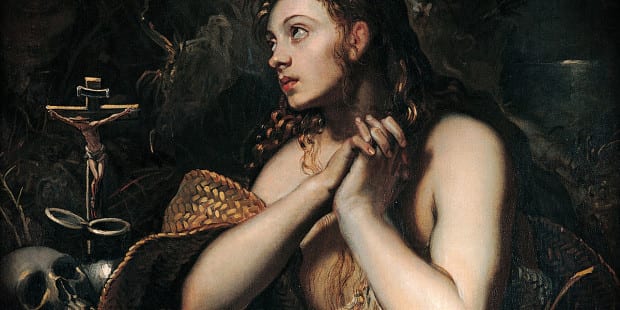SUNDAY, JULY 22..The New Feast of Saint Mary Magdalene …Was She a Prostitute and Why It Really Does Not Matter
Posted Originally at Aleteia.org
“Equal to the Apostles”
First Witness of the Resurrection (First Century)
Her life
+ Mary of Magdala features prominently in each of the gospels and she is most especially celebrated for her fidelity to Jesus during his Passion.

+ The Gospel of John highlights her importance when it describes her as going to Jesus’ tomb alone and discovering that the body of the Lord is missing. In tears, she says to the angels at the tomb, “They have taken my Lord away sand I do not know where have put him” (20:1-18). Moments later, Jesus appeared to her, making her the first witness of the Resurrection.
+ Various legends grew up around Mary Magdalene, including the unfounded assumption that she was a reformed prostitute. Today she is honored as a patron saint of contemplative nuns.
Worth knowing
In 2016 Pope Francis elevated the liturgical celebration of Saint Mary Magdalene to the rank of “Feast,” making her celebration equal to that of the other Apostles.
Quote
“It is likely to be a long time… before the identification of Mary Magdalen (sic) as a reformed prostitute disappears from art, hagiography, and popular consciousness… It would be altogether more in keeping with her privileged position accorded her by all the Gospel writers to stress her role as the bringer of the good news, the herald of Christ’s resurrection, a symbol of hope.” –Butler’s Lives of the Saints
Prayer
O God, whose Only Begotten Son
entrusted Mary Magdalene before all others
with announcing the great joy of the Resurrection,
grant, we pray,
that through her intercession and example
we may proclaim the living Christ
and come to see him reigning in your glory.
Who lives and reigns with you in the unity of the Holy Spirit,
one God, for ever and ever. Amen.
(from The Roman Missal)
Saint profiles prepared by Brother Silas Henderson, S.D.S.
And why it doesn’t really matter if she was or wasn’t …
Scholars of culture, Scripture, and history like to debate about the identity of Mary Magdalene. Was she a prostitute? Why did seven demons have to be cast out of her, as mentioned in Mark 16:9 and Luke 8:2?
A new voice has come into the debate: Author Jennifer Ristine is releasing in Magdala on Mary Magdalene’s feast day her book Mary Magdalene: Insights from Ancient Magdala.
Ristine considers the debate, but insists that Mary Magdalene’s history is not the point to dwell upon.
“Amidst the obscurity of her life, one fact is certain. Her life radically changed upon meeting Jesus of Nazareth, so much so that she followed Him to the foot of the cross,” Ristine notes at Magdala.com.
She explains how the “before and after conversion” of Mary Magdalene is juxtaposed with John 8’s account of the adulteress woman and John 12’s Mary of Bethany who anoints Jesus with expensive nard.
“Early Church Fathers of the East and West debated whether these ‘three women’ were one and the same.”
Ristine notes how the Eastern Church generally came to consider them three separate women, while “the Western Church remained steadfast in identifying them as one and the same woman, Mary Magdalene.”
Various eras saw the debate intensify, for example during the Protestant Reformation and during the mid-20th century.
Ristine notes, “Some authors associated her with ‘Miriam Megaddlela’ or Miriam with the braided locks, named in the second-century Talmud. This title refers to a woman’s hairdresser, which connotes ‘prostitute,’ or someone involved in a non-reputable occupation.”
But she wasn’t a poor prostitute from the streets; “Luke 8:3 alludes to her wealth, naming her first among other women who cared for Jesus out of their own sustenance. One of the women in her company was Johanna, the wife of Herod’s steward, and possibly a woman involved in the court life. Was Mary Magdalene among those women as well?”
“The Talmud recognizes Magdala as a prosperous city with an immoral reputation. Its demise in 67 AD by Roman troops is seen as a punishment for its wickedness. How does this cultural context influence the imagination of women of the first century? Were young women, such as Mary Magdalene, enticed by the pagan Roman culture?”
Again, however, what is certain is that Mary’s life was transformed, and she became one of Christ’s most intimate followers, at the foot of the Cross, and then in the garden before dawn, the first to witness the Resurrection.
“From Mary Magdalene’s story,” Ristine says, “we could paint her as an icon of hope. Mary was certainly a curious onlooker, as so many were in Jesus’ day as he went about the towns of Galilee teaching in the synagogues, preaching the Good News and healing all kinds of illnesses. Surely she heard Jesus’ invitation: ‘Repent and believe in the Gospel, for the Kingdom of God is at hand.’ Her final unguardedness let the love of Jesus become effective in her heart. And it was rewarded with a growing passion to follow Him and be the privileged first to announce the Good News that Jesus had not died, but truly lived. It is an invitation that continues to echo today to all who wish to experience a true transformation of the deepest kind.”





